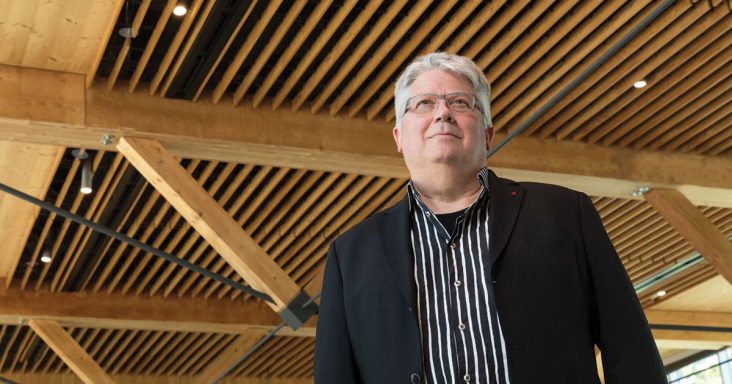Dean MacKeith helped to introduce mass timber to state
by September 17, 2024 3:33 pm 451 views

Peter MacKeith, dean of the University of Arkansas Fay Jones School of Architecture and Design
Mass timber products have become significant to many large construction projects in Northwest Arkansas thanks in part to the advocacy of Peter MacKeith, dean of the University of Arkansas Fay Jones School of Architecture and Design.
MacKeith became a fast advocate for these products when he joined the UA more than 10 years ago. The advocacy has led to multiple large-scale mass timber projects on campus, timber executive gifts to the UA and piqued the interest of Bentonville retailer Walmart enough to use mass timber products to construct its new home office.
According to WoodWorks, mass timber products are engineered wood building materials made by layering and bonding wood. They are code-certified internationally and can be used for frames, floors, roofs and walls. The most common products include cross-laminated timber (CLT), glue-laminated timber (glulam) and dowel-laminated timber. CLT and glulam have been used in the most significant projects in Northwest Arkansas.
Many drivers led MacKeith to introduce mass timber products to Arkansas. One was the state’s robust timber commodity. According to a 2024 report from the Arkansas Economic Development Commission, forests cover 19 million acres or 56.6% of the state’s land. Forest volumes have nearly doubled to 1,200 million tons in 2022 from 611 million tons in 1978. And there’s no sign of slowing growth. In 2020, the state’s investment in tree planting totaled 169,807 acres. In the South, Arkansas is No. 1 for the number of hardwood seedlings grown and No. 2 for the total number of seedlings grown.
According to the report, forest products provide more than 50,803 direct and indirect jobs at nearly 500 locations, largely in rural areas. Average wages are $61,626, slightly behind the national wage index. Forestry contributes 4.1% to the state’s economy. Its added value impact is more than $6.1 billion, and the value of standing timber is $12.6 billion.
In 2023, the state exported $483.47 million in forest products, up 45.7% from $331.75 million in 2022 and 68.2% from $287.51 million in 2021. The top three export countries are Mexico, China and Turkey.

“Arkansas sits in this fantastic location of the United States, where it has river transportation, road transportation, rail transportation — all the logistics you could want if you were looking to establish new factories,” MacKeith said. “It has all the fiber, meaning all the wood that you might want if you were looking to set up a wood products factory. And it has some degree of available capital or venture capital if that was necessary to explore for a business opportunity.”
MacKeith highlighted the opportunity for the continued growth of forests and the economic impact of forest products as other drivers that led him to introduce mass timber products for area construction projects. Connecting his drive to the UA architecture school’s namesake, MacKeith said renowned architect E. Fay Jones designed his signature work, Thorncrown Chapel in Eureka Springs, primarily built of Arkansas lumber.
UNIVERSITY PROJECTS
On campus, MacKeith said the UA has invested about $250 million in projects that use mass timber products. He added that the UA is one of the leading U.S. universities in this type of on-campus construction.
UA Libraries high-density storage annex was built with mass timber to reduce costs and construction time, MacKeith said. In 2019, Adohi Hill opened as the first large-scale mass timber residence hall built in the United States. Its construction led Walmart leaders to inquire about using mass timber, which it’s using for its new home office.
Now, the UA is building the 44,800-square-foot Anthony Timberlands Center for Design and Materials Innovation in its Art and Design District on Martin Luther King Jr. Boulevard and the 144,000-square-foot Institute for Integrative and Innovative Research building at Dickson and Duncan streets. Both are being built with mass timber products. The previous, which is expected to open with the start of the fall 2025 semester,, has garnered international attention, accolades and the support of John Ed and Isabel Anthony.
In 2018, the Anthonys made the lead $7.5 million gift for the center, which will focus on design innovation in timber and wood. In October 2022, they made a $2.5 million gift to support the future naming of a fabrication space in the center in honor of MacKeith, who said this was an honor and deepened his stewardship for the school.
John Ed Anthony, founder and chairman of Anthony Timberlands Inc., said soon after MacKeith arrived in Arkansas, he saw the potential of the state’s forests. MacKeith introduced Anthony to how mass timber products have been used in European construction projects in other parts of the world, including Finland, where MacKeith lived and worked for 10 years after initially going there as a Fulbright Scholar.
MacKeith noted the Fulbright connection as another driver leading him to introduce mass timber here. The UA College of Arts and Sciences was named after J. William Fulbright, a U.S. senator and UA president and law professor.
WALMART PROJECT
Another large-scale project in Northwest Arkansas using mass timber products is the Walmart Home Office in Bentonville. The company plans to use at least 1.1 million cubic feet of CLT in the 350-acre project.
“Walmart is dedicated to maintaining cost efficiency and thoughtful design in our new home office, illustrated notably through the incorporation of mass timber,” according to a Walmart spokesperson. “The use of mass timber not only connects our associates with nature within their workspace but also showcases the innovative use of traditional, regenerative resources in the construction of over 2.4 million square feet of office space.”
MacKeith said the use of mass timber in this project is more than a large-scale proof of concept but “a confirmation that this is a material and a technology … being valued by one of the most significant corporations in the world … but of course now being represented to us in our region locally. So there’s a number of dimensions to Walmart’s commitment to this, which I think are significant.”
Mercer Mass Timber, which operates a 283,000-square-foot plant in Conway, is providing the mass timber products for the Walmart and UA projects using timber from southern states, predominantly from Arkansas forests and sawmills. Mercer Mass Timber also operates plants in Spokane, Wash., and Okanagan, Canada.
Asked about the next big mass timber projects in Arkansas, MacKeith looks to see how the products will be used in large-scale public and private office buildings of up to 10 stories tall and how they can be used for affordable and attainable housing.
“The greatest amount of wood utilized in American construction is in residential construction,” he said. “There is an almost desperate need for housing in our region as well as all across the United States and elsewhere in the world. I would like to believe, and we certainly are attempting to propose that mass timber of one form or another can have a role to play in addressing those critical needs.”
Hobbs State Park-Conservation Area in Rogers will host a free program on the design and use of CLT in construction at the park’s visitor center at 2 p.m. Sept. 15. MacKeith will be the guest speaker.
